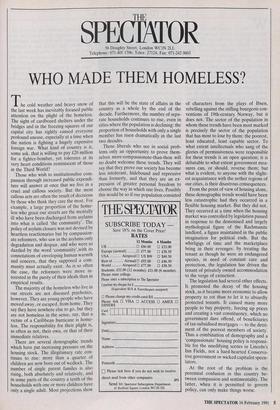SPECTAT THE OR
56 Doughty Street, London WC1N 2LL Telephone: 071-405 1706; Telex: 27124; Fax: 071-242 0603
WHO MADE THEM HOMELESS?
The cold weather and heavy snow of the last week has inevitably focused public attention on the plight of the homeless. The sight of cardboard shelters under the bridges and in the freezing squares of our capital city has rightly caused everyone profound unease, especially at a time when the nation is fighting a hugely expensive foreign war. What kind of country is it, some ask, that is willing to pay £20 million for a fighter-bomber, yet tolerates at its very heart conditions reminiscent of those in the Third World?
Those who wish to institutionalise com- passion through increased public expendi- ture will answer at once that we live in a cruel and callous society. But the most callous acts are often the result of decisions by those who think they care the most. For example, a large proportion of the home- less who grace our streets are the mentally ill who have been discharged from asylums into what is called 'the community'. The policy of asylum closure was not devised by heartless reactionaries but by compassion- ate reformers, who saw in the asylums only degradation and despair, and who were so dazzled by the word `community',with its connotations of enveloping human warmth and concern, that they supposed a com- munity must actually exist. As is so often the case, the reformers were more in- terested in the purity of their ideals than in empirical results. The majority of the homeless who live in our streets are not diseased psychotics, however. They are young people who have moved away, or escaped, from home. They say they have nowhere else to go, but they are not homeless in the sense, say, that a victim of a Caribbean hurricane is home- less. The responsibility for their plight is, as often as not, their own, or that of their immediate relatives.
There are several demographic trends which have put increasing pressure on the housing stock. The illegitimacy rate con- tinues to rise: more than a quarter of children are now born out of wedlock. The number of single parent familes is also rising, both absolutely and relatively, and in some parts of the country a tenth of the households with one or more children have only a single adult. Most projections show that this will be the state of affairs in the country as a whole by the end of the decade. Furthermore, the number of sepa- rate households continues to rise, even in cities where the population is declining: the proportion of households with only a single member has risen dramatically in the last two decades.
Those liberals who see in social prob- lems only an opportunity to prove them- selves more-compassionate-than-thou will no doubt welcome these trends. They will say that they prove our society has become less intolerant, hidebound and repressive than formerly, and that they are an ex- pression of greater personal freedom to choose the way in which one lives. Possibly this would be so if our population consisted
of characters from the plays of Ibsen, rebelling against the stifling bourgeois con- ventions of 19th-century Norway, but it does not. The sector of the population in whom these trends have been most marked is precisely the sector of the population that has most to lose by them: the poorest, least educated, least capable sector. To what extent intellectuals who sang of the glories of permissiveness were responsible for these trends is an open question; it is debatable to what extent government mea- sures can, or should, reverse them; but what is evident, to anyone with the slight- est acquaintance with the nether regions of our cities, is their disastrous consequences.
From the point of view of housing alone, these demographic trends would have been less catastrophic had they occurred in a flexible housing market. But they did not. They occurred at a time when the housing market was controlled by legislation passed in response to the demonised and largely mythological figure of the Rachmanite landlord, a figure maintained in the public imagination for political ends. But the whirligigs of time and the marketplace bring in their revenges: by treating the tenant as though he were an endangered species, in need of constant care and protection, the legislation has driven the tenant of privately owned accommodation to the verge of extinction.
The legislation had several other effects. It promoted the decay of the housing stock, as it became more economic to allow property to rot than to let it to absurdly protected tenants. It caused many more people to buy property, forcing up prices and creating a vast constituency, which no government dare offend, of beneficiaries of tax-subsidised mortgages — to the detri- ment of the poorest members of society. Thus a combination of demography and a 'compassionate' housing policy is responsi- ble for the unedifying scenes in Lincoln's Inn Fields, not a hard-hearted Conserva- tive government or wicked capitalist specu- lators.
At the root of •the problem is the perennial confusion in this country be- tween compassion and sentimentality. The latter, when it is permitted to govern policy, can only make things worse.


















































 Previous page
Previous page